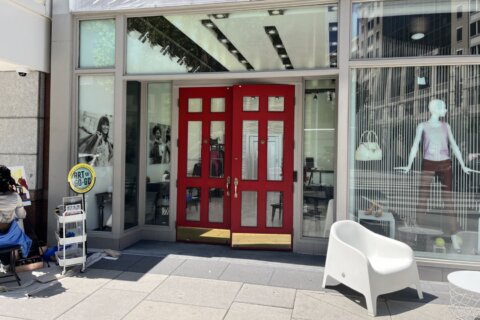When Black students at Georgetown University published a guide to help other students in the community, there wasn’t really anyone on campus to use it when coronavirus pandemic-related restrictions and closures hit.
“The Black Book of Georgetown,” which was published in April, offers historical knowledge of the school, contact information on community and faculty support, and off-campus spots for beauty supplies and good eats.
The students who created the guide are hoping the shared knowledge of the school’s history with race, integration and restitution, as well as offering safe spaces for students of color, will serve as a resource for years to come.
They didn’t realize what it would do to assuage the concerns of incoming Black students unsure if a predominantly white university was right for their college experience.
Josiah Laney, one of the creators of the Black Book, told WTOP that the book is a collaboration between community groups on and off campus, as well as businesses and professors who offer an open door to students from the community.
The virtual document is a list, as well as a history of race and slavery at the university and in the D.C. neighborhood as a whole.
“The Black Book is intended to help Black students in their transition to Georgetown,” Laney said. “The document compiles a list of resources available to support Black students both on and off campus, as well as a brief section on Georgetown’s Black history.”
But when the COVID-19 pandemic hit, Laney said the Black Book unexpectedly served as a touchstone for prospective high school students who could not visit campus.
With Hoya Saxa visiting weekends canceled, community groups were able to distribute the Black Book virtually to assure incoming freshman that there was a place for them at Georgetown, Laney said.
“This resource, it took on a new significance because it could show them some of the communities; it gave them a preview. And it was just a really great mark to show the level of camaraderie and collaboration that we have here among the Black community,” Laney said.
As a freshman, Laney found it personally difficult to find support systems on campus, which he shared to Hoya senior features editor Ashley Zhao. He said after moving to campus from Los Angeles, he didn’t get a haircut as a freshman simply because he didn’t know where to go.
“These questions brought me a lot of anxiety when I thought about attending a predominantly white institution as the Black kid from L.A. I never visited the campus either, so when I arrived in August, impostor syndrome was in full effect,” Laney said. “I also went all fall semester without getting a haircut because I didn’t know who to ask. This is the exact document that would have helped me feel confident, and stories like mine are the reason that it was produced.”
He said it speaks broadly to the resources that are still needed, both on and off campus, for students of color.
Georgetown University has publicly acknowledged its past and links to slavery. In 1838, the university sold 272 enslaved people in order to keep the school running.
In recent years, the Jesuit institution has tried to right its wrongs by rededicating buildings and by creating an annual $400,000 reparations fund following a student vote in support of the idea.
The challenge in passing down to the next class what they’ve learned is what gave Laney and his partners the idea for the book, which he said was created out of love.
Though, since last spring break, Georgetown students have largely been back at home and not on campus to use the new resource. That distance also made reporting on the book’s publication tricky for Zhao.
“We really wanted to get as many voices that were representative of the book and the voices behind it as possible,” said Zhao, who wrote about the Black Book for school paper The Hoya.
There are plans in the future to publish “books” for other community groups by partnering with Latino and Asian school organizations, for example.
“I definitely do think research like this are [sic] so important for students of color. Georgetown obviously has made a lot of progress. It’s a much better place to be now, but it’s important to still recognize that this space was not originally created for a lot of us, and there’s still a long way to go,” said Zhao, noting that she was sharing her perspective also as a student of color.








